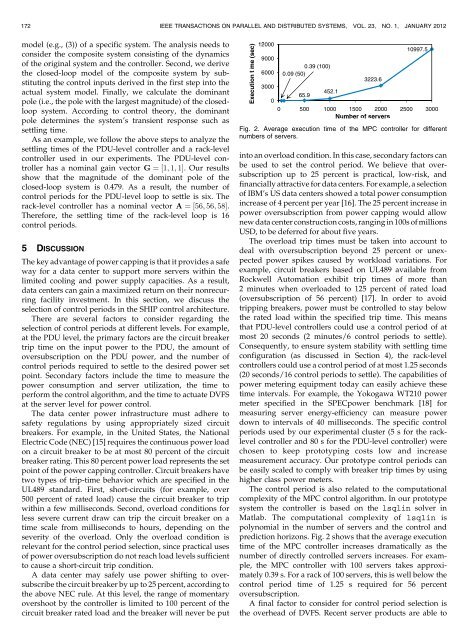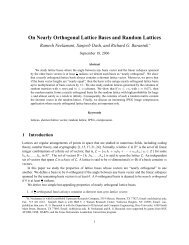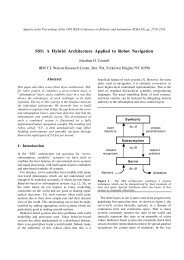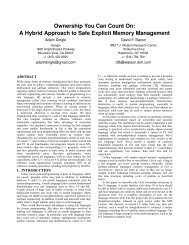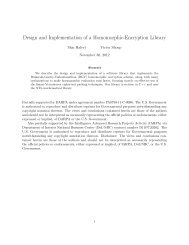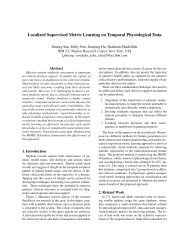SHIP: A Scalable Hierarchical Power Control ... - IEEE Xplore
SHIP: A Scalable Hierarchical Power Control ... - IEEE Xplore
SHIP: A Scalable Hierarchical Power Control ... - IEEE Xplore
Create successful ePaper yourself
Turn your PDF publications into a flip-book with our unique Google optimized e-Paper software.
172 <strong>IEEE</strong> TRANSACTIONS ON PARALLEL AND DISTRIBUTED SYSTEMS, VOL. 23, NO. 1, JANUARY 2012model (e.g., (3)) of a specific system. The analysis needs toconsider the composite system consisting of the dynamicsof the original system and the controller. Second, we derivethe closed-loop model of the composite system by substitutingthe control inputs derived in the first step into theactual system model. Finally, we calculate the dominantpole (i.e., the pole with the largest magnitude) of the closedloopsystem. According to control theory, the dominantpole determines the system’s transient response such assettling time.As an example, we follow the above steps to analyze thesettling times of the PDU-level controller and a rack-levelcontroller used in our experiments. The PDU-level controllerhas a nominal gain vector G ¼½1; 1; 1Š. Our resultsshow that the magnitude of the dominant pole of theclosed-loop system is 0.479. As a result, the number ofcontrol periods for the PDU-level loop to settle is six. Therack-level controller has a nominal vector A ¼½56; 56; 58Š.Therefore, the settling time of the rack-level loop is 16control periods.5 DISCUSSIONThe key advantage of power capping is that it provides a safeway for a data center to support more servers within thelimited cooling and power supply capacities. As a result,data centers can gain a maximized return on their nonrecurringfacility investment. In this section, we discuss theselection of control periods in the <strong>SHIP</strong> control architecture.There are several factors to consider regarding theselection of control periods at different levels. For example,at the PDU level, the primary factors are the circuit breakertrip time on the input power to the PDU, the amount ofoversubscription on the PDU power, and the number ofcontrol periods required to settle to the desired power setpoint. Secondary factors include the time to measure thepower consumption and server utilization, the time toperform the control algorithm, and the time to actuate DVFSat the server level for power control.The data center power infrastructure must adhere tosafety regulations by using appropriately sized circuitbreakers. For example, in the United States, the NationalElectric Code (NEC) [15] requires the continuous power loadon a circuit breaker to be at most 80 percent of the circuitbreaker rating. This 80 percent power load represents the setpoint of the power capping controller. Circuit breakers havetwo types of trip-time behavior which are specified in theUL489 standard. First, short-circuits (for example, over500 percent of rated load) cause the circuit breaker to tripwithin a few milliseconds. Second, overload conditions forless severe current draw can trip the circuit breaker on atime scale from milliseconds to hours, depending on theseverity of the overload. Only the overload condition isrelevant for the control period selection, since practical usesof power oversubscription do not reach load levels sufficientto cause a short-circuit trip condition.A data center may safely use power shifting to oversubscribethe circuit breaker by up to 25 percent, according tothe above NEC rule. At this level, the range of momentaryovershoot by the controller is limited to 100 percent of thecircuit breaker rated load and the breaker will never be putFig. 2. Average execution time of the MPC controller for differentnumbers of servers.into an overload condition. In this case, secondary factors canbe used to set the control period. We believe that oversubscriptionup to 25 percent is practical, low-risk, andfinancially attractive for data centers. For example, a selectionof IBM’s US data centers showed a total power consumptionincrease of 4 percent per year [16]. The 25 percent increase inpower oversubscription from power capping would allownew data center construction costs, ranging in 100s of millionsUSD, to be deferred for about five years.The overload trip times must be taken into account todeal with oversubscription beyond 25 percent or unexpectedpower spikes caused by workload variations. Forexample, circuit breakers based on UL489 available fromRockwell Automation exhibit trip times of more than2 minutes when overloaded to 125 percent of rated load(oversubscription of 56 percent) [17]. In order to avoidtripping breakers, power must be controlled to stay belowthe rated load within the specified trip time. This meansthat PDU-level controllers could use a control period of atmost 20 seconds (2 minutes/6 control periods to settle).Consequently, to ensure system stability with settling timeconfiguration (as discussed in Section 4), the rack-levelcontrollers could use a control period of at most 1.25 seconds(20 seconds/16 control periods to settle). The capabilities ofpower metering equipment today can easily achieve thesetime intervals. For example, the Yokogawa WT210 powermeter specified in the SPECpower benchmark [18] formeasuring server energy-efficiency can measure powerdown to intervals of 40 milliseconds. The specific controlperiods used by our experimental cluster (5 s for the racklevelcontroller and 80 s for the PDU-level controller) werechosen to keep prototyping costs low and increasemeasurement accuracy. Our prototype control periods canbe easily scaled to comply with breaker trip times by usinghigher class power meters.The control period is also related to the computationalcomplexity of the MPC control algorithm. In our prototypesystem the controller is based on the lsqlin solver inMatlab. The computational complexity of lsqlin ispolynomial in the number of servers and the control andprediction horizons. Fig. 2 shows that the average executiontime of the MPC controller increases dramatically as thenumber of directly controlled servers increases. For example,the MPC controller with 100 servers takes approximately0.39 s. For a rack of 100 servers, this is well below thecontrol period time of 1.25 s required for 56 percentoversubscription.A final factor to consider for control period selection isthe overhead of DVFS. Recent server products are able to


